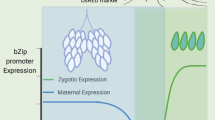Abstract
The use of genetically modified mosquitoes to reduce or replace field populations is a new strategy to control mosquito-borne diseases. The precondition of the implementation of this strategy is the ability to manipulate the genome of mosquitoes and to induce specific expression of the effector molecules driven by a suitable promoter. The objective of this study is to evaluate the expression of defensin A gene of Anopheles sinensis under the control of a vitellogenin promoter in transgenic Anopheles stephensi. The regulatory region of Anopheles gambiae vitellogenin was cloned and subcloned into transfer vector pSLFa consisting of an expression cassette with defensin A coding sequence. Then, the expression cassette was transferred into transformation vector pBac[3xP3-DsRedafm] using Asc I digestion. The recombinant plasmid DNA of pBac[3xP3DsRed-AgVgT2-DefA] and helper plasmid DNA of phsp-pBac were micro-injected into embryos of An. stephensi. The positive transgenic mosquitoes were screened by observing specific red fluorescence in the eyes of G1 larvae. Southern blot analysis showed that a single-copy transgene integrated into the genome of An. stephensi. RT-PCR analysis showed that the defensin A gene expressed specifically in fat bodies of female mosquitoes after a blood meal. Interestingly, the mRNA of defensin A is more stable compared with that of the endogenous vitellogenin gene. After multiple blood meals, the expression of defensin A appeared as a reducible and non-cycling type, a crucial feature for its anti-pathogen effect. From data above, we concluded that the regulatory function of the Vg promoter and the expression of defensin A gene were relatively conserved in different species of anopheles mosquitoes. These molecules could be used as candidates in the development of genetically modified mosquitoes.
Similar content being viewed by others
References
Guinovart C, Navia M M, Tanner M, et al. Malaria: Burden of disease. Curr Mol Med, 2006, 6(2): 137–140
Anon. Prospects for malaria control by genetic manipulation of its vectors (TDR/BCV/MAL-ENT/91.3). Geneva: World Health Organization, 1991
Varmus H, Klausner R, Zerhouni E, et al. Public health. Grand challenges in global health. Science, 2003, 302: 398–399
Christophides G K. Transgenic mosquitoes and malaria transmission. Cell Microbiol, 2005, 7(3): 325–333
Catteruccia F, Benton J P, Crisanti A. An Anopheles transgenic sexing strain for vector control. Nat Biotechnol, 2005, 23: 1414–1417
Yoshida S, Watanabe H. Robust salivary gland-specific transgene expression in Anopheles stephensi mosquito. Insect Mol Biol, 2006, 15: 403–410
Kokoza V, Ahmed A, Cho W L, et al. Engineering blood meal-activated systemic immunity in the yellow fever mosquito, Aedes aegypti. Proc Natl Acad Sci USA, 2000, 97: 9144–9149
Vernick K D. Mechanisms of immunity and refractoriness in insect vectors of eukaryotic parasites. In: Brey B T, Hultmark D, eds. Molecular Mechanisms of Immune Responses in Insects. London: Chapman & Hall, 1998. 261–309
Blandin S, Shiao S H, Moita L F, et al. Complement-like protein TEP1 is a determinant of vectorial capacity in the malaria vector Anopheles gambiae. Cell, 2004, 116: 661–670
Matsuyana K, Natori S. Purification of three antibacterial proteins from the culture medium of NIH-Shape-4, an embryonic cell of Sarcophaga peregrina. J Biol Chem, 1988, 263: 17112–17116
Lambert J, Keppi E, Dimarcq J L, et al. Insect immunity: Isolation from immune blood of the dipteran Phormia terranovae of two insect antibacterial peptides with sequence homology to rabbit lung macrophage bactericidal peptides. Proc Natl Acad Sci USA, 1989, 25: 867–873
Dimarcq J L, Hoffmann D, Meister M, et al. Characterization and transcriptional profiles of a Drosophila gene encoding an insect defensin. Eur J Biochem, 1994, 221: 201–209
Chalk R, Albuquerque C M, Ham P J, et al. Full sequence and characterization of two insect defensins: Immune peptides from the mosquito Aedes aegypti. Proc R Soc Lond B Biol Sci, 1995, 161: 217–402
Eggleston P, Lu W, Zhao Y. Genomic organization and immune regulation of the defensin gene from the mosquito, Anopheles gambiae. Insect Mol Biol, 2000, 9: 481–490
Zhang Y J, Chen X G, Zheng X L, et al. Cloning and identification of the genomic and cDNA sequences of defensin gene from Anopheles sinensis. Chin J Parasitol Parasit Dis (in Chinese), 2006, 24(1): 35–41
Ito J, Ghosh A, Moreira L A, et al. Transgenic anopheline mosquitoes impaired in transmission of a malaria parasite. Nature, 2002, 417: 452–455
Horn C, Wimmer E A. A versatile vector set for animal transgenesis, Dev Gene Evol, 2000, 210: 630–637
Horn C, Schmid B G, Pogoda F S, et al. Fluorescent transformation markers for insect transgenesis. Insect Biochem Mol Biol, 2002, 32: 1221–1235
Sambrook L, Fritsch E F, Maniatis. Molecular Cloning. 2nd ed. New York: Cold Spring Harbor Laboratory Press, 1989. 474–483
Church G M, Gilbert W. Genimic sequencing. Proc Natl Acad Sci USA, 1984, 81(7): 1991–1995
Schneider D S, James A A. Bridging the gaps in vector biology. Workshop on the molecular and population biology of mosquitoes and other disease vectors. EMBO Rep, 2006, 7(3): 259–262
James A A. Gene drive systems in mosquitoes: Rules of the road. Trends Parasitol, 2005, 21(2): 64–67
Lombardo F, Nolan T, Lycett G, et al. An Anopheles gambiae salivary gland promoter analysis in Drosophila melanogaster and Anopheles stephensi. Insect Mol Biol, 2005, 14: 207–2126
Abraham E G, Donnelly-Doman M, Fujioka H, et al. Driving mid-gut-specific expression and secretion of a foreign protein in transgenic mosquitoes with AgAper 1 regulatory elements. Insect Mol Biol, 2005, 14: 271–279
Kokoza V A, Martin D, Mienaltowski M J, et al. Transcriptional regulation of the mosquito vitellogenin gene via a blood meal-triggered cascade. Gene, 2001, 274: 47–65
Shin S W, Kokoza V A, Raikhel A S. Transgenesis and reverse genetics of mosquito innate immunity. J Exp Biol, 2003, 206(Pt 21): 3835–3843
Author information
Authors and Affiliations
Corresponding author
Additional information
Supported by the National Natural Science Foundation of China (Grant No. 30271162) and the Chinese Scholarship Council (Grant No. 2003365035)
About this article
Cite this article
Chen, X., Zhang, Y., Zheng, X. et al. Robust and regulatory expression of defensin A gene driven by vitellogenin promoter in transgenic Anopheles stephensi . Chin. Sci. Bull. 52, 1964–1969 (2007). https://doi.org/10.1007/s11434-007-0292-z
Received:
Accepted:
Issue Date:
DOI: https://doi.org/10.1007/s11434-007-0292-z




